|
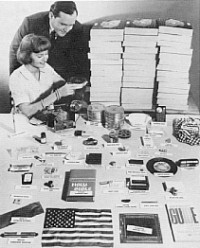
|
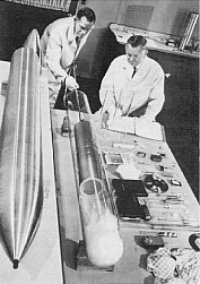
|
| Objects to be included in Westinghouse Time
Capsule II (left) include 50-star flag, a Beatles record and
Birth Control pills. Stack of telephone books represents the
number of pages of microfilmed information. |
Westinghouse technicians load contents into
the inner glass crypt of Time Capsule II (right). Plaid bikini
swimsuit is shown in the lower right portion of this photo. Capsule
design is similar to the capsule buried in 1938. |
|
OBJECTS TO BE INCLUDED IN WESTINGHOUSE TIME CAPSULE II
- The strides civilization has taken in the past 25 years are
reflected in the objects which will be buried for 5,000 years
in Westinghouse Time Capsule II.
-
- Some of the 45 articles were unheard-of a quarter of a century
ago while others represent radical changes since Time Capsule
I was entombed in 1938.
-
- Citizens 25 years ago would have been startled to learn that
part of a space ship -- a piece of the re-entry heat shield from
Lt. Cmdr. M. Scott Carpenter's Mercury spacecraft Aurora 7 --
would be included in today's Time Capsule.
-
- On the other hand, eye glasses were a commonly used article
in 1938. But the advanced development and wide acceptance of
contact lenses has accomplished a major advance in this field.
Similarly, ball point pens, automatic cameras and electric toothbrushes
represent significant refinements of common articles not foreseen
a quarter century ago.
-
- A complete list of objects that will be buried in Time Capsule
II on October 16, 1965, follows:
|
Articles in Common Use
|
1. |
A 50-star U.S. Flag -- |
reflecting admission to the Union of Hawaii and Alaska. |
|
2. |
Bible -- |
new revised edition in modern English provided by the American
Bible Society. |
|
3. |
Credit cards -- |
Diner's Club and American Express. |
|
4. |
Electronic watch -- |
employing principle of natural vibration to tell time electrically.
Provided by Bulova Watch Company. |
|
5. |
Automatic camera -- |
provided by Polaroid Corporation. |
|
6. |
Contact lenses -- |
provided by Wesley-Jessen, Chicago. |
|
7. |
Freeze-dried food -- |
beef meat packed in nitrogen atmosphere by Campbell Soup Company. |
|
8. |
Plastic wrap -- |
used chiefly in preserving foods. |
|
9. |
Bikini bathing suit -- |
provided by Jantzen, Inc. |
|
10. |
Long-playing record -- |
The Beatles rendition of "A Hard Day's Night." |
|
11. |
Rechargeable flashlight -- |
replaces conventional throw-away cells with type which can be
recharged over and over from ordinary electric socket. |
|
12. |
Ball point pen -- |
provided by Parker Pen Company. |
|
13. |
Detergent -- |
provided by Lever Brothers. |
|
14. |
Transistor radio |
|
|
15. |
Tranquilizer pills |
|
|
16. |
World's Fair Guidebook |
|
|
17. |
Electric toothbrush |
|
|
18. |
Pack of filter cigarettes |
|
Atomic Energy
|
19. |
Film badge -- |
measures low level of radiation accumulated over a long period.
Provided by the Atomic Energy Commission. |
|
20. |
Pocket radiation monitor -- |
provides immediate warning of radiation by an audible tone and
flashing light. Provided by Oak Ridge National Laboratory. |
|
21. |
Sample of Carbon 14 -- |
a standardized radioactive isotope, especially useful in geological
dating up to 25,000 years. Provided by Westinghouse. |
|
22. |
Fermi reactor graphite -- |
from world's first nuclear reactor built under West Stands, Stagg
Field, University of Chicago. On December 2, 1942, the first
self-sustaining chain reaction proved that man could harness
the energy of the atom. Provided by the Atomic Energy Commission. |
|
23. |
Nautilus film history -- |
world's first atomic-powered submarine. Film strip provided by
Westinghouse and U.S. Navy. |
|
24. |
Calder Hall film -- |
film of Queen Elizabeth II opening the world's first nuclear
power station at Calder Hall, England, October 1956, provided
by the United Kingdom Atomic Energy Authority. |
Scientific Developments
|
25. |
Antibiotics -- |
representing a family of drugs that combats many diseases more
effectively than any others previously in existence. Provided
by Lederle Laboratories, Inc. |
|
26. |
Synthetic fibers -- |
samples of Orlon, Dacron and Lycra. Provided by E.I. duPont de
Nemours & Co. |
|
27. |
Pyroceram -- |
a partially crystallized glass that has unusual resistance to
cracking or breaking due to extreme changes in temperature. Provided
by Corning Glass Works. |
|
28. |
Computer memory unit -- |
an electronic means of storing information in a computer so that
it can be quickly recovered at any time. Provided by Univac Division,
Sperry Rand Corporation. |
|
29. |
Plastic heart valve -- |
man-made product that can replace a malfunctioning part of the
human body. Provided by Edwards Laboratories, Inc., Santa Ana,
Calif. |
|
30. |
Superconducting wire -- |
a special alloy that shows no electrical resistance at temperatures
near absolute zero; made possible super-strength magnets. Provided
by Westinghouse. |
|
31. |
Ruby laser rod -- |
makes possible the amplification of light by millions of times
in the form of a coherent beam. Provided by the Linde Company. |
|
32. |
Normal and irradiated seeds of grain -- |
seeds that have been exposed to varying degrees of radiation
which may cause basic changes in the plants' growth. Provided
by Brookhaven National Laboratory, Upton, Long Island, N.Y. |
|
33. |
"Fresh" seawater -- |
Pacific Ocean water that was converted into pure drinking water
at Point Loma, Calif., seawater conversion plant. |
|
34. |
Permanent magnet -- |
made of particles of ceramic materials which exhibit magnetic
properties superior to those found in metals. |
|
35. |
Birth control pills -- |
|
|
36. |
Molecular blocks |
which integrate into small solid blocks of material the functions
usually performed by an entire assembly of electronic components.
Provided by Westinghouse. |
|
37. |
Sequoia wood sample -- |
material which shows the natural radiation level in the atmosphere
over long periods of time. Provided by the Redwood Empire Association,
Calif. |
Space
|
38. |
Re-entry heat shield -- |
a piece from the Mercury Aurora 7 spacecraft flown by Lt. Cmdr.
M. Scott Carpenter on his three-orbital flight, May 24, 1962.
Provided by National Aeronautics and Space Administration's Manned
Space Center, Houston, Texas. |
|
39. |
Vanguard I parts -- |
solar cell powering a microminiaturized radio transmitter of
satellite. Provided by Goddard Space Flight Center. |
|
40. |
Echo II material -- |
outside "skin" from balloon satellite. Provided by
Langley Research Center, NASA. |
|
41. |
Fuel cells -- |
device which chemically generates electricity without moving
parts. Provided by Westinghouse |
|
42. |
Fiber-reinforced metal -- |
experimental material for space applications requiring extreme
strengths and low weights. |
|
43. |
Tektite -- |
material similar to granite believed to have come from the moon
and thought to be between 600,000 and 30,000,000 years old. Provided
by Goddard Space Flight Center, NASA. |
Other
|
44. |
16 mm. microfilm -- |
approximately twelve 200-foot reels of microfilm containing more
than 50,000 pages of information, including National Geographic
Atlas of the World, World Almanac, United Nations Statistical
Yearbook, Statistical Abstract of the United States, National
Industrial Conference Board Economic Almanac and numerous other
encyclopedic works. |
|
45. |
Sounds of our times -- |
tape recording of famous sounds and voices of the past 25 years. |
SOURCE: Westinghouse
Press Release, undated
|
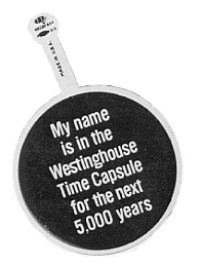
|
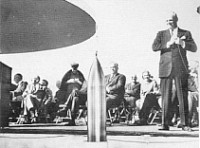
|
| A popular souvenir of the Fair. Visitors received
these pin-backs after signing their names in a book to be microfilmed
and included with the contents of Time Capsule II for burial. |
Time Capsule II is lowered to its final resting
place on "Time Capsule Day" at the Fair -- October
16, 1965 -- to be unearthed again in A.D 6939. |
SOURCE: (all) Westinghouse
Promotional Photos.
The Supplement to
The Book of Record
With the advent of Time
Capsule II, Westinghouse had to update The Book of Record
with the fact that a new Time Capsule was buried ten feet from
the original Capsule at the close of the 1964/1965 New York World's
Fair. The supplement, shown below, gives a description of the
purpose and location of Time Capsule II.
|
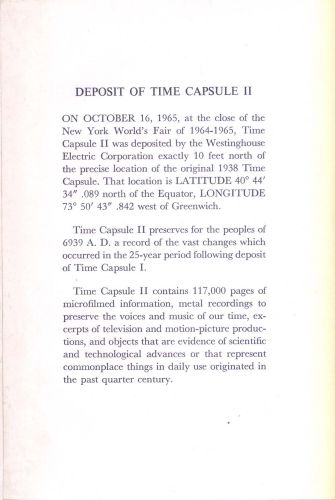
|
SOURCE: Richard Post
Collection
In 1989 the Queens Museum at
Flushing Meadows presented a retrospective exhibit on the 50th
and 25th anniversaries of the New York World's Fairs. Among the
exhibits they displayed were the cut-away models of the Time Capsules
on loan from Westinghouse. Photos of the exhibit, taken then,
show how the capsules were packed. (photos courtesy of Bradd Schiffman © 2002 Bradd Schiffman, all rights reserved)
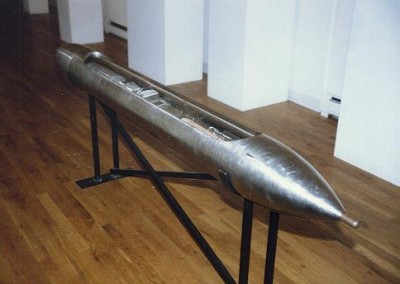 |
Round containers
in the front of the Capsule hold the microfilm update of 25 years
of events that occurred after the first Time Capsule was buried
in 1938.
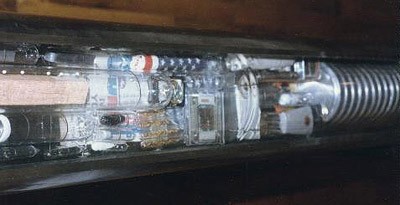 |
The Beatles "A Hard Day's Night"
45-rpm record can be seen at the back of the capsule. The red
light tipped Radiation Detector is near the top.
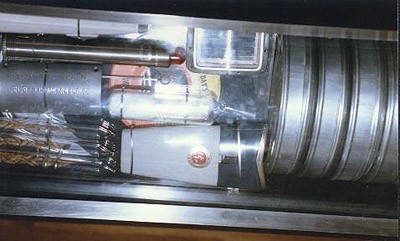 |
Plaid Bikini is discernible
in the background. Transistor radio is to the right. Photo also
shows the World's Fair Guidebook, American Express credit card
and the 50-star US Flag. It is interesting to note that American
Express thought to VOID their credit card! Looking ahead, perhaps
they didn't want anyone making unauthorized charges in 6939?
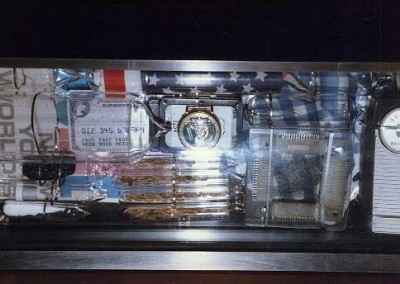 |
Artificial Heart
Valve is silvery round object with white front in the center of
the photo.
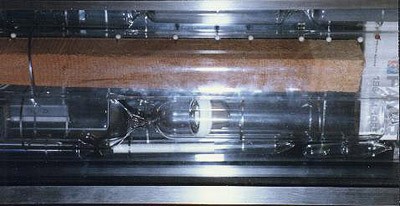 |
|